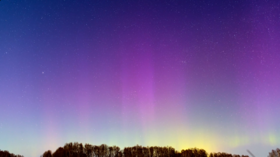Hot pink northern lights illuminate skies over Russia (VIDEO)

The northern lights lit up above several regions in central Russia on Friday night with bright ribbons of pink, green, and purple light.
People from the regions of Chelyabinsk, Ryazan, Penza, Vladimir, Sverdlovsk, Kurgan, Novosibirsk, Moscow, and Nizhny Novgorod posted online stunning photographs of the phenomenon. The northern lights are seldom seen in many of these regions.
The unusually intense light show was caused by strong solar storms that lasted about five hours, according to the Russian Academy of Sciences.
The northern lights, also known as the aurora borealis, are caused by electrically charged particles from the Sun colliding with the Earth’s upper atmosphere. The phenomenon is primarily observable in regions located around the Arctic Circle. It is best seen at night between the months of September and April.
Most aurora displays are predominantly green but can also include a range of other colors, such as pink, dark red, blue, and purple. Pink displays, such as the ones seen in Russia on Friday, are quite rare and tend to be caused by a solar storm making a temporary hole in the magnetosphere that allows solar particles to reach deeper into the Earth’s atmosphere than usual. At lower altitudes the atmosphere has a higher percentage of nitrogen, which lights up in a different hue than oxygen.












